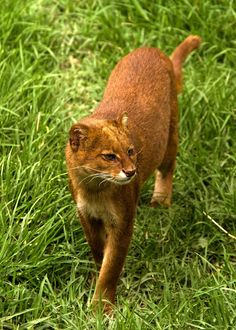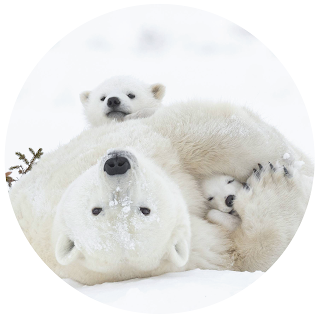Utah Prairie Dog - Jacqueline Ng
 |
| Utah Prairie Dogs peeking from their burrow Image Courtesy of Kevin Doxstater |
These cute little friends we have here on the right image are Cynomys parvidens, also known as Utah prairie dogs.
Summary description and ecology of organism
Although these little fellows are called Utah prairie "dogs", they are rodents a part of the squirrel family. Their physical appearance is similar to the figure of a squirrel, just without furry the tail. The fur of a Utah prairie dog consists of a tan brown with dark brown hints on the tips of the hair. The Utah prairie dog has lighter tones of white/tan from the bottom of it's chin to it's stomach. The size of one is about 30-36cm long.
Utah prairie dogs are herbivorous; they generally prefer eating grasses but will consume flowers in shrubs if needed. They are considered a keystone species -- a species on which other species in an ecosystem largely depend, if it were removed the ecosystem would change drastically -- because they decrease vegetation height from consumption as well as burrowing in soil that promotes uptake in nitrogen of plants. With the vegetation and soils, wildlife species such as burrowing owls, rabbits, ground squirrels, weasels, and badgers rely on the habitat conditions that the Utah prairie dogs create.
The Utah prairie dog is a part of the Cynomys genera, along with four other species: white-tailed, black-tailed, Gunnison's, and Mexican prairie dog. Breeding of these prairie dogs occur from mid-March until around early April. They spend 4-6 months underground each year during harsh winter months. Utah prairie dogs have their own language with each other through different call sounds and behavior. If you're interested about how they communicate, you can learn more about it through this study.
____________________________________________________________________________________________________________ |
| Utah Prairie Dog Recovery Unit Boundaries Map Courtesy of US Fish and Wildlife Service |
Geographic and Population Changes
Utah prairie dogs can only be found in southwestern and central Utah. Of the other prairie dog species, Utah prairie dogs have the most restricting range within the US. Today they are limited to the central and southwestern quarter of Utah.
Utah prairie dogs occur in colonies scattered across the landscape. Some of the colonies function as meta-populations -- a group of populations that are separated by space but consist of the same species; the spatially separated populations interact as individual members move from one population to another. Over the past 30 years, observations indicate that individual colonies “crash” and recolonize. Crashes may be caused by plague, unlawful lethal control, and habitat alteration. Larger colonies of Utah prairie dogs (more than 40 counted adults) are more likely to persist because they have a lower probability of crashing.
____________________________________________________________________________________________________________
Listing Date and Type of Listing
Listed as "endangered" species on June 4, 1973.
Downlisted to "threatened" in 1984.
This is because the Utah prairie dog’s range-wide population has been stable to increasing over the last 30 years.
Downlisted to "threatened" in 1984.
This is because the Utah prairie dog’s range-wide population has been stable to increasing over the last 30 years.
____________________________________________________________________________________________________________
Cause of Listing and Main Threats to Its Continued Existence
 |
| Utah prairie dog munching on grass Image Courtesy Rick Fridell |
The populations of Utah prairie dogs began to decline in the 1920s. This was when lethal control programs, such as poisoning, were initiated. Along with sylvatic plague -- a non-native disease transmitted by fleas -- and habitat alteration, from over-grazing and large scale agriculture, impacted the species' distribution.
Utah prairie dogs were threatened with extinction due to habitat destruction and modification, over-exploitation, disease, and predation at the time of listing.
Here are tiers of threats that Utah prairie dogs face today:
Utah prairie dogs were threatened with extinction due to habitat destruction and modification, over-exploitation, disease, and predation at the time of listing.
Here are tiers of threats that Utah prairie dogs face today:
- Main critical threats: plague, habitat fragmentation (urban expansion)
- Other important threats: overgrazing, cultivated agriculture, invasive plants
- Minor threats: climate change, poaching, fire management, predation
____________________________________________________________________________________________________________
 |
| Utah prairie dogs on privately owned golf course Image courtesy of Brian Slobe |
Description of Recovery Plan
The recovery strategy for Utah prairie dog focuses on habitat loss and fragmentation and disease. Habitat protection, research, and monitoring are encompassed in the strategy program for the species. The plan emphasizes on conservation of the species on non-federal lands through programs with willing landowners and includes increasing and securing populations of the Utah prairie dog on public land. If conservation of the species is increased on lands that somehow benefits both private landowners and Utah prairie dogs, then recovery of the species will be achieved in a quicker manner.
Overall, the plan emphasizes: conserving colonies; establishing additional colonies on both public and private lands through habitat improvement or translocations; being able to control the transmission of plague; and monitoring habitat conditions.
Some proposed recovery actions include:
Some proposed recovery actions include:
- Continuing Utah prairie dog annual surveys and population monitoring
- Conserving prairie dog habitat on non-federal lands
- purchasing conservation easements and establishing voluntary conservation agreements (ex, safe harbor agreements) with willing landowners
- Protecting and improving habitat on federal lands
- implementing vegetation treatments and minimizing impacts of proposed land use activities
- Minimizing impacts of disease such as plague
- Continuing the translocation of Utah prairie dogs to establish new colonies in suitable habitats
- Developing a more comprehensive public outreach effort to promote a better understanding of the biological and habitat values of the Utah prairie dog.
The recovery plan is more in-depth with specifics on US Fish and Wildlife Service's goals and objectives for the Utah prairie dog.
____________________________________________________________________________________________________________
What can you do?
 |
| Image courtesy of Wildlife Reflections Photography |
- Stay informed and educated!
- Keep updated with this important species and how they are doing.
- Spread the word and share your voice!
- Let people know about Utah prairie dogs and their conditions and how you feel about their status.
- Donate to help conservation!
- You can help by "adopting" a prairie dog!
____________________________________________________________________________________________________________
How much did you learn?
Test your knowledge on Utah prairie dogs here :)
____________________________________________________________________________________________________________
Resources
Utah Prairie Dog. National Parks Service, 24 Feb. 2015,
https://www.nps.gov/brca/learn/nature/upd.htm
Utah Prairie Dog Final Revised Recovery Plan. US Fish and Wildlife Service, Mar. 2012,
https://ecos.fws.gov/docs/recovery_plan/1203012_UTPD_RevisedRecoveryPlan_Final.pdf
Utah Prairie Dog Progress Towards Recovery. US Fish and Wildlife Service, June. 2014,
https://www.fws.gov/mountainprairie/factsheets/UtahPrairieDog__ProgressTowardsRecovery_061714.pdf
https://www.nps.gov/brca/learn/nature/upd.htm
Utah Prairie Dog Final Revised Recovery Plan. US Fish and Wildlife Service, Mar. 2012,
https://ecos.fws.gov/docs/recovery_plan/1203012_UTPD_RevisedRecoveryPlan_Final.pdf
Utah Prairie Dog Progress Towards Recovery. US Fish and Wildlife Service, June. 2014,
https://www.fws.gov/mountainprairie/factsheets/UtahPrairieDog__ProgressTowardsRecovery_061714.pdf



Really liked how you underlined the main points within the paragraphs, makes it easy for someone to skim your blog and still get the main idea. However, a graph on the population changes would have been helpful. I really like the last section "how much did you learn?" its a nice addition.
ReplyDeleteBy: Sage Massey
DeleteYour blog is well organized and looks very nice visually. I like the amount of detail that you provide and how the main point are laid out. I thought it was very creative the have the "How Much Did You Learn" section.
ReplyDelete-Mckenna Moura
Your passion for this animal is evident throughout the blog. The map helps a lot to visually understand the geographic range of this animal. The captions help give good context to the pictures. LOVE the attached quiz.
ReplyDelete-Perry Nalle
Your blog is very professional and well organized. I thoroughly enjoyed all your pictures of these interesting animals and your descriptive and informative writing. I think you did a really great job of talking about why this species is threatened.
ReplyDelete-Parker Ornellas
I'm from Minnesota originally and the prairie is very dear to me. Thank you for writing about such an important keystone species for this valuable ecosystem. I can see why habitat loss is a leading cause of their endangerment. The prairie has suffered great degradation in favor of agriculture over the years and it is so sad to see.
ReplyDelete-Shannon O'Hehir
Your blog is very well-informed. I really enjoyed your pictures and you also explained prairie dog's situation well.
ReplyDelete-Christine Okimura
I loved the test at the end of the blog to see how much information I absorbed. Good touch. Also the image of the prairie dogs with their hands on each other's backs was adorable!
ReplyDelete-Fiona McCallion
Your blog had a lot of pictures that are engaging and informative. The description of the recovery plan was very clear and easy to comprehend. It was interesting to see how poisoning and plague initially affected the species.
ReplyDelete-Kristen Nagamatsu
I thought that the "crashing" that occurs with colonies was very interesting and how they recolonize after.
ReplyDelete-Bryn Mulligan
They are so cute! Are the private golf courses affecting them in any way, or are they helping to recover? Very interesting.
ReplyDelete-Ali Murray